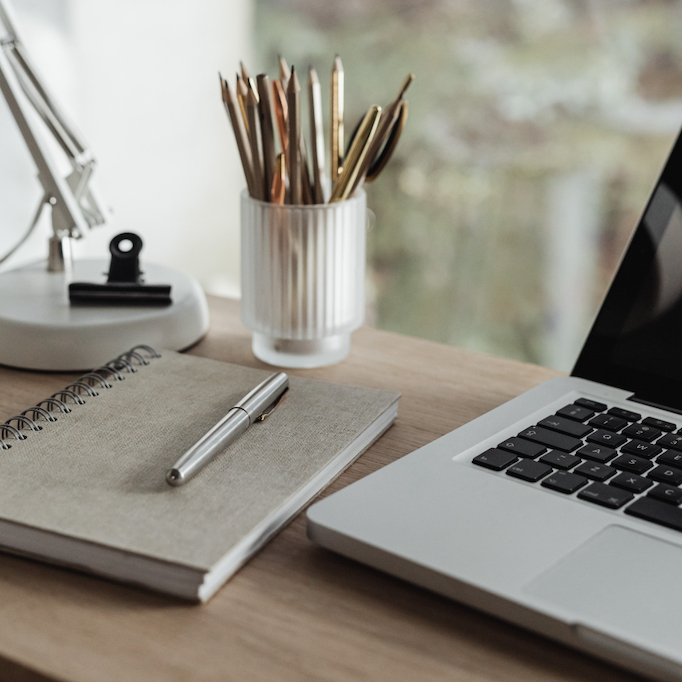
Do you have a home office or study in your house or apartment?
Are you looking to create a work environment that fits your needs?
In this post, you’ll find a few practical tips to help you organize a home office.
Keep in mind, these tips will show you how to set up the general layout of your home office.
Having the right layout in place can make your workspace that much more productive and welcoming.
Identify workspace tasks.
An office is always an office, right?
Well, that’s not always the case.
It depends on your profession and how you utilize the space in your office.
If you were a graphic designer, you’d probably use your office quite differently than if you were a virtual assistant, writer, musician, accountant, or marketing consultant.
So what’s the easiest way to determine how you use your home office?
Simply create a brief list of tasks you complete on a regular basis in your line of work.
For example, a graphic designer might list the following tasks for her office:
- Work in design programs on computer with graphics tablet, mouse, and keyboard
- Use email, word processing document, and internet on computer to prepare proposals and conduct research
- Use printer to print out designs and images
- Cut, trim, and matte print outs and other materials
- Refer to concepts, sketches, and notes
- Refer to design and typography books
- Use past client files
- Meet face-to-face with clients
See how easy that was? Now, it’s time for you to create your own list.
How do you use your home office? Here’s a few items to get you started:
- Electronic Devices. Do you need to use a computer and printer?
- Working Areas. Is a clean, flat surface on which to collate, construct, or build items important to you?
- Physical Storage. Do you need to store physical files, books, blueprints, designs, or magazines?
- Wall space. Do you use wall space to mount ideas, proposals, and plans?
- Environment. Do you need plenty of sunlight, open floor space, and a cozy sitting area to meet with clients?
Add on any and all tasks you think are important.
Create appropriate work zones or areas.
The next step is to carve out areas in your office in which you will do your work.
Things might be a bit jumbled at the moment, but don’t worry, we are going to put things in order right now!
We’re going to create a little map of your office. Here’s what you need to do:
Pull out a large sheet of paper and draw a rectangle or square to represent your office.
Next, add in doors, windows, and furniture to represent the current layout of your office.
When you’re finished, make brief notes about where you currently perform tasks.
From our example above, the graphic designer might sketch out her office’s work zone.
She may realize all her digital devices, books, supplies, materials, and furniture, are confined in and around her computer desk.
Having reviewed this current layout, she realizes she’s not adequately using her entire office space.
Next, you’re going to pull out another large sheet of paper to create a new diagram or layout of your office.
This time, however, you’re going to add in new work areas that you think would suit your office best.
So, our graphic designer friend might create something like the following:
- Computer desk and chair: Work in design programs on computer; prepare proposals, and conduct research
- Drafting table: Use printer to print designs and images, etc.; cut, trim, and matte print outs and other materials
- Corner conversation area with comfortable chairs, coffee table, and small bookcase: refer to design and typography books; meet face-to-face with clients
- Filing cabinet and bulletin board: refer to past client files; refer to concepts, sketches, and notes
Reorganize items as necessary.
Now, it’s time to adjust the layout of your office based on your notes from above.
It can help to make a little plan before you get started.
All you have to do is reference your work zone or area list to create a few key action steps.
In our example, the graphic designer might make the following plan:
Computer desk and chair
1. Items stay as they are
Drafting table
1. Move drafting table to far wall
2. Unplug and move printer to drafting table
3. Move drawing, cutting and trimming tools to drafting table
Corner conversation area
1. Move comfortable chairs and coffee table to area
2. Remove all books from bookcase
3. Move bookcase to far side of room
4. Remove all books from desk area and anywhere else in the office and place in bookcase
Filing cabinet and bulletin board area
1. Remove files from filing cabinet
2. Move filing cabinet to area next to desk
3. Replace files into filing cabinet
4. Mount bulletin board next to desk
5. Take materials from desk, and mount on bulletin board
Depending on how many things you have in your office, this reorganization process can take anywhere from an hour or two, to more than four hours.
Be sure to set aside enough time in your schedule for the layout change.
You should also keep in mind that this reorganization will probably involve some heavy lifting on your part, be it moving materials and supplies, furniture and the like.
You may want to think about recruiting some help, especially for heavier or more unwieldy items.
How about you? Do you like the current layout of your home office or are you going to change it? Join the conversation and leave a comment below!





0 Comments